Artful Displays: Enhancing Shark Tooth Collections
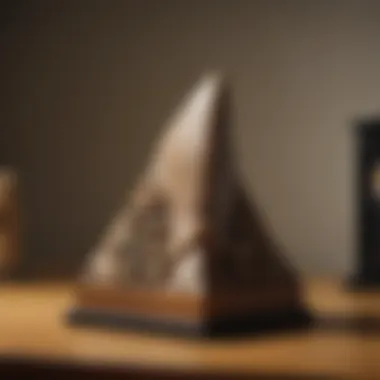
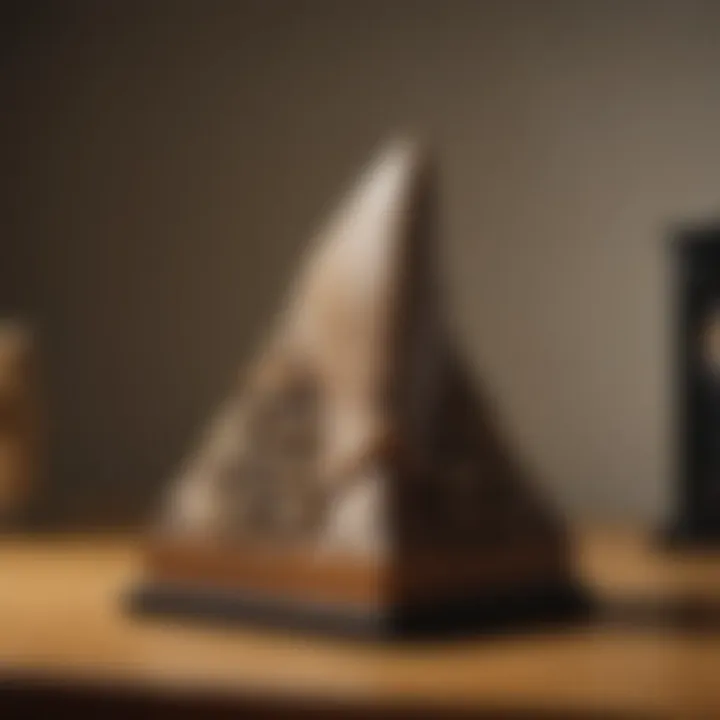
Intro
In the vibrant world of fossil collection, shark teeth have a distinct allure. Each tooth holds within it a narrative—of ancient oceans, predatory giants, and the forces of nature itself. However, capturing the full essence of these pieces often goes beyond mere collection. Properly displaying shark teeth not only amplifies their visual appeal but also preserves their integrity. This is where the art of shark tooth display stands comes into play.
A well-crafted display stand serves more than a utilitarian purpose; it is a statement piece that showcases the collector's passion. Selecting the appropriate stand can transform a simple collection into a striking visual narrative. This article embarks on a journey through the realm of shark tooth display stands, emphasizing their importance in both aesthetics and preservation.
Featured Collectible of the Month
Overview
This month’s highlight is the Mako Shark Tooth, prized for its unique serration and impressive size. Found in a variety of colors from pristine white to deep brown, these teeth are not just relics of the past—they are a testament to the incredible biology of Sharks. Their sleek form and sharp edges make them a favorite among enthusiasts.
Display stands designed specifically for Mako Shark Teeth not only place a spotlight on their captivating features but also educate on their evolutionary significance.
Historical Significance
Mako sharks, existing for over 20 million years, have played a vital role in marine ecosystems. Collecting their teeth is not only about possession; it links the collector to a rich history. Display stands honoring the Mako Shark Tooth often bear designs that echo the ocean's fluidity, creating a complementary relationship between the piece and its surroundings.
"In understanding the history of these ancient predators, we uncover the deep connection between nature and our own ecological journey."
Identification Techniques
Visual Characteristics
To truly appreciate a shark tooth display stand, recognition of specific traits falls into play. Attributes like size, shape, and color variation in the Mako teeth can enhance identification. The family of teeth from different shark species varies significantly:
- Mako Shark Teeth: Characterized by long, narrow shapes with deep grooves.
- Hammerhead Teeth: Wider and more robust, often with unique serration.
- Great White Teeth: Large, triangular, and unmistakably intimidating.
Each type requires different display techniques to ensure their distinct characteristics are prominently featured.
Resources for Identification
Navigating the vast sea of shark teeth can be daunting. The advent of digital age resources can lighten this burden:
- Wikipedia: A starting point for general knowledge on shark species and their teeth.
- Britannica: A reliable source for historical and biological context.
- Reddit: A community offering shared experiences and identification help.
- Facebook: Various groups devoted to fossil collecting can serve as informative spaces.
Thus, with the right knowledge and tools, collectors can forge deeper connections with their displays, turning each shark tooth into a narrative of natural history, resilience, and personal devotion.
Preamble to Shark Tooth Collecting
Shark tooth collecting is not just a curious hobby; it’s an engaging pursuit that opens doors to the rich tapestry of our planet's geological past. The versatility and artistic potential of shark teeth have attracted many enthusiasts from various backgrounds. Collectors aren't merely gathering fossilized remnants; they are piecing together the history of ancient marine life, often passed down through generations. The story behind each tooth—its shape, size, and origin—adds layers of significance beyond just aesthetics.
When we explore shark tooth collecting, a few key points spring to mind. First off, the variety of shapes and sizes provides an endless source of fascination. From the classic, triangular shape of the great white shark tooth to the unique serrated edges of a megalodon, each specimen tells a tale of its evolutionary journey. Furthermore, the thrill of discovery—whether at a beach, a fossil site or during a trade show—is a pivotal aspect of the excitement surrounding this hobby. Not to mention, the social component can't be overlooked; connecting with fellow collectors creates a shared community that enriches the experience.
Apart from the joy of collecting, another essential element is the aspect of preservation. Shark teeth can be delicate, and ensuring they are displayed in a way that maintains their integrity is crucial. Therefore, selecting appropriate display stands becomes a significant consideration. Below, we delve farther into the captivating allure of these ancient treasures.
The Allure of Shark Teeth
The enchantment surrounding shark teeth is hard to put into words; they possess a magnetism that draws collectors in. Their shapes—sometimes sleek and polished, and other times rough and jagged—spark curiosity about the vast ocean life that existed millions of years ago. For many, the thrill is in the search; combing through sandy beaches or even underwater sites provokes the same excitement one might experience when uncovering buried treasure.
What adds to this allure further, are the stories behind these teeth. They are remnants of creatures that ruled the oceans, some of which, like the megalodon, evoke images of colossal beasts. This historical perspective fuels the passion amongst collectors, allowing them to feel a connection with the depths of the earth's history.
Collecting shark teeth isn’t just a hobby; it’s a gateway into an ancient world filled with wonders and mysteries waiting to be unearthed.
Historical Context of Shark Tooth Collecting
The tradition of shark tooth collecting is steeped in history, tracing back to ancient civilizations. Coastal communities have long regarded shark teeth as precious relics. Native Americans, for instance, utilized these teeth in tools and ceremonial objects. In other cultures, they even served as talismans, believed to ward off evil spirits or provide protection on a journey.
As time marched on, shark tooth collecting transitioned into a more leisure-focused activity, especially with the rise of fossil hunting in the 19th century. During this time, individuals began systematically collecting and studying these ancient artifacts, combining leisure with a budding interest in the sciences.
Today, the practice is often celebrated in museums and educational institutions. Display exhibits of shark teeth not only captivate audiences but also serve educational purposes—demonstrating biodiversity and the evolutionary lineage of sharks. This dual role of preservation and admiration emphasizes the importance of continuing to collect and appreciate these unique fossils.
Understanding Shark Tooth Display Stands
When it comes to showcasing one’s collection of shark teeth, the display stand plays a pivotal role. Not only do these stands facilitate the preservation of each tooth, they also offer a way to highlight their unique features and historical context. A well-designed display stand ensures that each piece is presented to its fullest potential. This aspect goes beyond mere aesthetics and enters the realms of education, helping collectors share their passion with others.
Purpose and Functionality
The primary purpose of shark tooth display stands can be boiled down to two concepts: protection and presentation. Shark teeth, like many fossils, are sensitive to environmental factors. Humidity, dust, and light can easily deteriorate their quality. A proper display stand shields these delicate relics from potential damage. Not to be overlooked is the functionality that a display stand brings. For collectors, it’s vital that the stand accommodates various sizes and shapes of teeth, allowing for a more curated and attractive display.
To consider purely functional aspects, here are a few key elements a good display stand should encompass:
- Stability: The structure should hold the teeth securely, minimizing the risk of slippage or fall.
- Accessibility: A well-planned stand makes it easy for the owner to rotate or rearrange the teeth as needed.
- Integration with Environment: The stand should blend seamlessly with the collector's decor, enabling the teeth and the stand to coexist beautifully.
Aesthetics vs. Practicality
In the world of display stands, a common tug-of-war exists between aesthetics and practicality. Collectors often find themselves pondering whether a stand that looks fantastic will function as intended, or if a more functional design compromises visual appeal.
Aesthetics matter a lot, no question about that. A striking display can truly captivate the viewer’s eye. Many collectors opt for stands that feature intricate designs or materials that complement the shark teeth's natural beauty. A wooden stand with a rich finish can evoke a sense of ancient charm, while a sleek metal design might appeal to modern sensibilities. Taking cues from design principles can amplify the overall presentation of the collection.
However, practicality must be a consideration too. For instance, a display stand that tilts at an angle may beautifully showcase the teeth, but does it hold them securely? A piece that looks impressive but isn't stable may result in a heartbreaking loss of a rare specimen. It’s critical to strike a balance between making the display beautifully appealing while ensuring that it serves its function well.
As a collector, it’s often wise to ask oneself: "Will this stand serve its purpose while enhancing the beauty of my shark teeth?" Finding that harmony is essential in selecting the perfect display solution.
"The right display can transform a mere collection into an engaging narrative, inviting viewers to appreciate the history encapsulated within each tooth."
A favorable combination of thoughtful design and functional attributes creates spaces where collectors feel their pieces are not simply displayed, but celebrated.
Types of Shark Tooth Display Stands
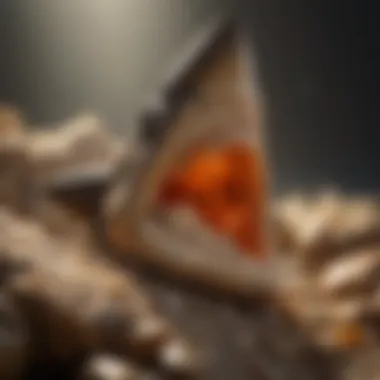
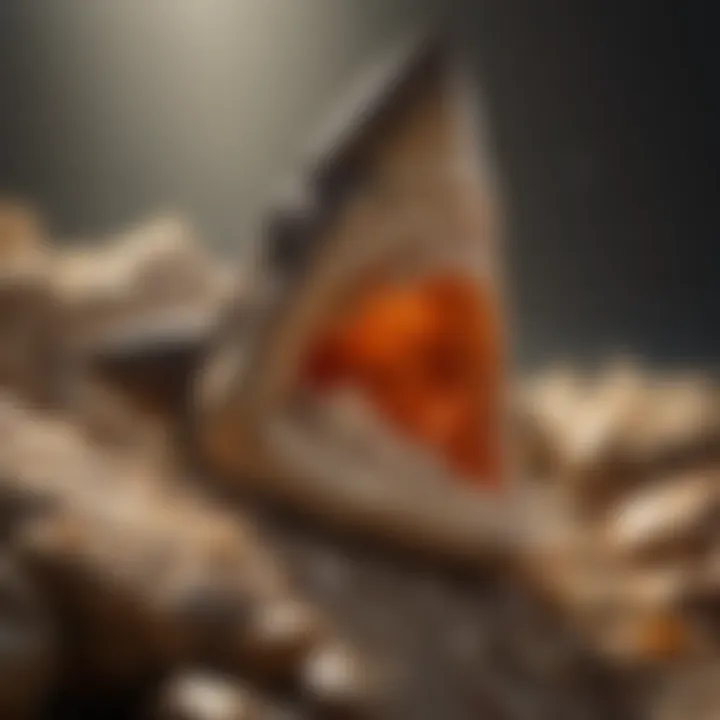
The choice of display stands for shark teeth is as crucial as the teeth themselves. These stands serve not just as holders but as a canvas that enhances the beauty and story behind each specimen. The variety in designs caters to different needs and preferences, and understanding these options can amplify one’s collection significantly.
Wall-Mounted Displays
Wall-mounted displays can transform a standard wall into an eye-catching exhibit of marine history. They provide an excellent way to utilize vertical space, allowing for an expansive presentation without sacrificing valuable table area. These displays can come in numerous styles, ranging from minimalist frames that emphasize the teeth to elaborate installations that mimic an undersea environment.
Key benefits include:
- Maximized Space: Perfect for collectors with limited room.
- Visibility: Teath can be arranged in patterns, making them more noticeable to onlookers.
- Sturdiness: Wall-mounted options can often hold heavier teeth securely.
However, collectors should consider the placement carefully. Too much direct sunlight can cause color fading over time, while humidity can affect both the teeth and the material of the display.
Tabletop Stands
Tabletop stands offer versatility and accessibility. They can be easily moved around, repositioned for optimal lighting, and arranged with other decor elements to complement one’s aesthetic. These stands are particularly useful for collectors who enjoy discussing their collections with visitors.
Some advantages include:
- Convenience: Easy to inspect and appreciate each tooth up close.
- Customizable Designs: Many options available in different shapes and materials.
- Freedom of Arrangement: Change the layout as desired.
It’s worth mentioning that while tabletop stands are easily accessible, they could be more vulnerable to accidental bumps or pets. It’s wise to ensure they are stable and suited for the intended environment.
Rotating Displays
For those who have a sizable collection and want to showcase multiple pieces efficiently, rotating displays take the cake. These stands allow the collector to display numerous shark teeth at once while requiring minimal space. The rotating mechanism creates a dynamic viewing experience, inviting guests to engage with the collection.
The perks of rotating displays include:
- Efficient Use of Space: Fit several specimens within a small footprint.
- Interactive Experience: Users can engage with the collection by turning the display.
- Stunning Visibility: Perfect for highlighting rare or unique pieces.
But potential buyers must ensure that the rotation is smooth and won’t cause damage to any delicate specimens.
Custom-Built Solutions
For collectors with a specific vision in mind, custom-built stands present an attractive option. These can be tailored in terms of dimensions, materials, and design, allowing a personal touch that reflects individual style and the uniqueness of their collection. Whether aiming for a marine-themed design or a more secular one, custom solutions can perfectly encapsulate the collector's aspirations.
Benefits include:
- Tailored Fit: Designed exactly for the dimensions and shapes of the teeth.
- Unique Materials: Opportunities to use eco-friendly or specialized materials.
- Personal Expression: Showcase personality through the design.
However, custom solutions can come at a premium price and may take longer to create. Collectors should weigh the desire for uniqueness against practicality.
Understanding the various types of shark tooth display stands helps collectors choose the right method to showcase their prized possessions. Each type has its own merits, whether maximizing display space or crafting a tailored experience that embodies one’s personal style.
Material Considerations for Display Stands
Understanding the materials used in crafting shark tooth display stands is crucial for collectors who wish to showcase their hard-won treasures effectively. The right material not only enhances the overall aesthetic appeal but also impacts the longevity and protection of the specimens on display. Choosing wisely between wood, acrylic, glass, and metal can make or break a collector's presentation. Each material offers unique benefits and considerations that can significantly influence how a collection is perceived and preserved.
Wooden Stands
Wooden stands are a classic choice for many collectors, offering a warm, organic feel that can beautifully complement the natural beauty of shark teeth. The textures and grains of wood can add a touch of artistry that enhances the visual interest of the display.
- Pros:
- Cons:
- Aesthetic Appeal: The natural look of wood can create a rustic, charming vibe, fitting for a collection of natural specimens.
- Customizability: Wood can be easily carved or stained to match personal tastes or decor styles.
- Durability: A well-crafted wooden stand can withstand the test of time, especially when treated properly with finishes to prevent warping or damage.
- Environmental Factors: Wood is susceptible to humidity and temperature changes, which can lead to expansions or contractions.
- Maintenance: Needs occasional polishing or treatment to maintain its appearance and durability.
- Cost: Quality hardwood can be more expensive than other materials.
Acrylic and Glass Options
Acrylic and glass stands are often seen as modern alternatives that prioritize sleekness and clarity. Such options prioritize the visibility of the collected items, allowing viewers to appreciate all the details without any visual obstruction.
- Pros:
- Cons:
- Clarity: Both acrylic and glass provide a transparent display that enhances visibility. This makes them perfect for showcasing intricately designed teeth.
- Easy Cleaning: The non-porous surfaces simplify the maintenance process, allowing for hassle-free cleaning and window views of your specimens.
- Contemporary Look: They lend a modern flair to any display, appealing to collectors who want a fresh, minimalist feel.
- Fragility: Both materials can break or shatter if mishandled. Glass, in particular, can pose safety risks if it fractures.
- Static Attraction: Acrylic, while durable, can become statically charged and attract dust, requiring more frequent cleaning.
- Cost: Depending on quality, certain types of acrylic or glass stands can be pricier than other materials.
Metal Displays
Metal stands offer a sturdier and often more industrial look, appealing to collectors who appreciate a unique aesthetic. They can come in various finishes and styles, enhancing the diversity of display options available.
- Pros:
- Cons:
- Strength: Metal can withstand significant weight and pressure, providing a stable base that’s less likely to tip over or collapse.
- Longevity: Resistant to wear and tear, making them a practical option for long-term display.
- Modern Aesthetic: Metal stands can create an edgy, contemporary feel that sets them apart from traditional wooden displays.
- Weight: Metal displays can be heavier, making them more cumbersome to move.
- Corrosion: If not treated properly, metal can rust or corrode over time, especially in humid environments.
- Heat Conductivity: Metal can heat up under sunlight, potentially affecting the integrity of sensitive specimens.
Choosing the right material for your shark tooth display stand is akin to finding the perfect frame for a priceless painting; it completes the look and enhances the overall experience.
Collectors should weigh these factors carefully before making a decision. Whether leaning toward warmth of wood, the clarity of acrylic or glass, or the durability of metal, each choice tells a story about not only the collector's taste but also their commitment to preserving and showcasing the beauty of shark teeth.
Design Considerations
When it comes to displaying shark teeth, the right design choices can make or break the aesthetic and functional aspects of a collection. Thoughtful design considerations can elevate a mere display into a unique showcase that highlights the intricacies of each specimen, while also ensuring they remain secure and accessible. Such choices span every component of a display stand, including its size, shape, material, and method of attachment. Key elements to consider include how visibility and security can coexist harmoniously and the visual impact of a display.
Balancing Visibility and Security
Collectors often find themselves walking a fine line between making their shark teeth visible and keeping them safe from potential damage. Visibility is crucial; each tooth tells a story, with its unique shape and history drawing in viewers. However, some display methods can come with risks. For instance, while a stand with open settings looks stunning, it may leave teeth vulnerable to accidents.
Here are some design tactics that can aid in balancing these two needs:
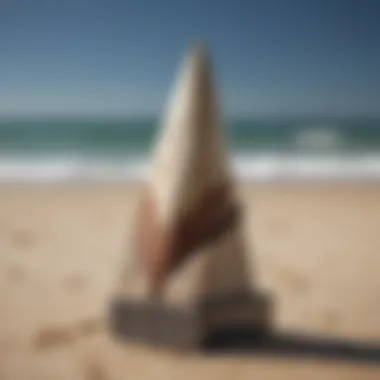
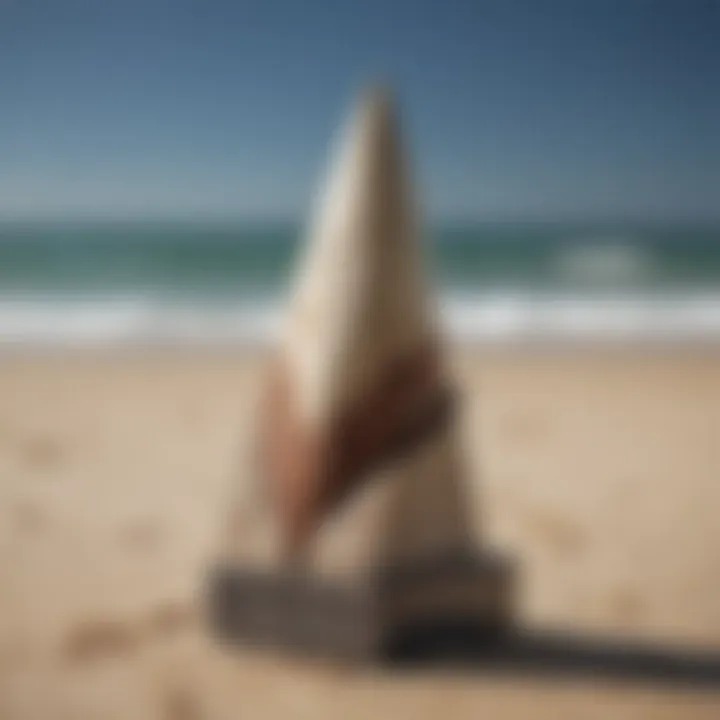
- Enclosed Cases: Using glass or acrylic cases can protect teeth from dust and accidental bumps while still allowing an unobstructed view. It's a win-win for both aesthetics and safety.
- Organizing Layout: Think about spacing. Ensuring there’s enough room between teeth avoids crowding and makes it easier to showcase each piece beautifully.
- Secure Mounting: Choosing attachments that firmly hold the teeth in place prevents any unfortunate slips or falls. Efficacy here can save a pricey specimen from cracking or breaking.
The considerations here are important for collectors who prioritize both the display's visual appeal and the integrity of the pieces displayed.
Enhancing Visual Appeal
The visual appeal of a shark tooth collection can be significantly augmented through savvy design choices. First impressions matter, especially in the world of collecting, where every detail counts. A well-designed stand not only presents the teeth but also highlights their unique features and context.
To enhance visual appeal, consider the following:
- Theme Consistency: Coordinating the design of your stand with the oceanic or prehistoric themes can weave a narrative that captivates viewers. For example, a display that resembles a rocky shoreline could deepen the connection to the sea.
- Color Coordination: Selecting stands in colors that complement the teeth can create a harmonious appearance. Neutral tones typically work well, allowing the natural colors of the teeth to pop.
- Lighting Effects: Utilize soft lighting, such as LED strips, to create an illuminating effect. Good lighting can actually change the perception of textures and hues in the shark teeth, drawing the eye to imperfections that enhance their authenticity.
A thoughtful design can indeed resonate, engaging those who stop to admire and learn about the hidden stories within every shark tooth.
Each of these elements can transform a simple display into a work of art, presenting not just the teeth but the entire passion behind the collection.
DIY Shark Tooth Display Stand Guide
Creating a DIY shark tooth display stand not only enhances the aesthetic of your collection but also provides a fulfilling way to engage with your hobby. Rather than settling for commercially available stands that might not suit your specific needs or taste, a custom display can be tailored to showcase your unique pieces in the best light possible. This process can also be economically beneficial, allowing you to use materials you may already have or can acquire at a low cost. Moreover, crafting your own display encourages a deeper connection to the objects you cherish—there's something to be said about having your handiwork support your prized finds.
In this guide, we’ll walk through the materials you will need, along with a concise yet thorough step-by-step method to create a stand that not only showcases your shark teeth beautifully but also preserves their condition.
Materials You Will Need
To embark on this DIY project, gather the following materials:
- Wood (like pine or plywood) for stability
- Acrylic Sheet (optional, for added clarity or modern aesthetics)
- Wood Glue or Strong Adhesive to bind pieces together
- Sandpaper to smooth edges and surfaces
- Saw (hand saw or power saw, depending on your comfort level) for cutting
- Drill (with bits suitable for wood) if you wish to add elements like hooks or additional features
- Paint or Stain (for finish) to match your home décor
- Ruler and Pencil to measure and mark your cuts
- Varnish (optional) for protective finishing
This selection gives you a solid foundation to create various types of stands, from rustic wooden displays to sleek acrylic designs. Personalize this list based on your vision, but these essentials are a great starting point.
Step-by-Step Instructions
Now let’s dive into the crafting process. Here’s how to create your unique display stand:
- Select Your Design: Start by deciding how you want your display to look. Consider the number of shark teeth you want to showcase and their sizes. Sketch a rough design to give you direction.
- Measure and Cut Your Material: Using your ruler, measure the dimensions of your intended stand. Cut your wood or acrylic accordingly. If you’re using multiple layers (like for a tiered stand), cut each layer to the same width but vary the lengths.
- Smooth the Edges: Use sandpaper to smooth any rough edges from your cuts. This not only helps in aesthetics but also in ensuring safety during handling.
- Assemble the Stand: Follow your design to glue the pieces together. For added strength, you can use nails or screws if appropriate. Apply weight to the structure as it dries to maintain stability.
- Paint or Stain: Once the glue is completely dry, apply your chosen paint or stain. Allow it to dry fully. This gives your stand a polished look that can complement your collection.
- Finishing Touches: If you opted for varnish, now is the time to apply it. This will not only enhance the shine but also protect the wood from any environmental factors.
- Add Shark Teeth: Once everything is dry, it's time to arrange your shark teeth! Position them in such a way that they stand out while ensuring they are secure.
Crafting your own display stand is an exercise in creativity that allows for personalization, making it truly yours.
With a little patience and creativity, you’ll have crafted a gorgeous display that complements your shark tooth collection while also serving as a conversation starter. The pride of displaying your own handiwork is a satisfaction that a store-bought solution often lacks.
Preservation and Care of Shark Teeth
When it comes to shark tooth collection, the preservation and care of these delicate specimens cannot be overstated. These pieces are not just remnants of a toothy predator; they are windows into the ancient past. Ensuring their longevity and beauty requires understanding the various elements that can influence their condition.
Environmental Influences
Shark teeth are susceptible to various environmental factors that could adversely affect their appearance and structural integrity over time. For instance, humidity and temperature fluctuations can lead to the degradation of these fossils. If kept in excessively humid conditions, moisture might encourage mold growth, tarnishing the tooth's surface.
Conversely, overly dry environments can cause cracking or brittleness. Therefore, storing shark teeth in a stable environment with controlled humidity levels—ideally around 30-50%—will go a long way in preserving their condition.
In terms of temperature, a controlled, cooler environment ideally between 65°F to 75°F should be maintained.
"The proper environmental conditions can make the difference between a fossil that's a treasured display piece and one that's lost to time."
Furthermore, sunlight can cause fading and discoloration. Keeping the display stands away from direct sunlight is paramount to preserving their vibrant colors. Glass display cases provide an additional barrier against dust and environmental pollutants, marking them as an excellent choice for collectors keen on maintaining pristine conditions.
Maintaining Display Stands
While the shark tooth itself is a subject of admiration, the display stand also plays a crucial role in the overall preservation strategy. The materials used in crafting these stands can impact how well the teeth are stored. For instance, wooden stands should be treated with care—using non-toxic sealants can minimize moisture absorption and protect from pests. Metal displays must be regularly checked for rust or corrosion, as these can easily transfer to the tooth and mar its quality.
Routine maintenance is essential. Here are a few practices to keep in mind:
- Cleaning: Regularly dust the display stands to prevent grime buildup, which can harbor moisture and foster mold. Use a soft, dry cloth to remove dust, avoiding harsh cleaners that could leave residues.
- Inspection: Periodically check each display for any signs of wear or damage. A loose screw in a tabletop stand could lead to a costly drop.
- Positioning: Reassess the positioning of stands regularly. To avoid accidents, ensure they are placed in secure areas away from foot traffic or handling.
By integrating these best practices into your collection routine, you'll not only highlight the beauty of your shark teeth but also extend their lifespan, allowing future generations to enjoy these remnants from the deep.
The Role of Display Stands in Education
Display stands serve a pivotal role in the world of education, particularly in fields like paleontology, geology, and natural history. For enthusiasts and educators alike, these stands are more than mere holders for shark teeth; they are essential tools that help in presenting information effectively and sparking curiosity. By showcasing collections in a well-thought-out manner, display stands can transform ordinary educational environments into interactive learning hubs.
Encouraging Interest in Paleontology
When well designed, shark tooth display stands can captivate the attention of students and the general public. The sight of meticulously arranged specimens can ignite a deeper fascination with paleontology. Instead of merely reading about ancient marine life, individuals can observe the actual remnants that tell stories from oceans long gone.
The physical act of displaying these teeth can inspire critical thinking. For example, discussions can arise about the evolution of sharks, the environment in which they lived, and even how climate change influences species survival today. Furthermore, organizing teeth by size or species invites inquiry into classification systems and the scientific method.
- Visual Impact: A visually appealing display can turn curiosity into exploration, encouraging students to delve into topics that piqued their interest.
- Hands-On Learning: When stands allow for interactivity, such as allowing touch or handling under supervision, learning becomes more tangible.
- Narrative Creation: Each shark tooth has a story; through displays, an educator can weave narratives that enhance engagement and retention of knowledge.
Utilizing Displays in Educational Settings
In classrooms and museums, the strategic use of display stands can significantly enhance the educational experience. Properly situated stands can guide the flow of information, leading visitors from one concept to another seamlessly. Organizing shark teeth by geographical location, for instance, can reveal information about historical oceanic changes and biodiversity.
Incorporating technology further amplifies this. Smart displays that incorporate QR codes linked to detailed articles or videos allow students and visitors to explore deeper concepts independently. This aligns with modern educational paradigms that encourage individual exploration and self-guided learning.
A few considerations for utilizing display stands in education include:
- Accessibility: Ensure that the displays are accessible to individuals of all ages and backgrounds.
- Safety and Security: Sharp edges and fragile items require attention to safety protocols, especially in school settings.
- Contextual Information: Accompanying the teeth with detailed descriptions enhances understanding, making them not just a visual artifact but a learning opportunity.
- Interactive Elements: Features like touchscreens or augmented reality can engage users without compromising the integrity of the fossils.
Display stands are not just items of decoration; they are fundamental in cultivating a rich educational experience that connects the past to the present and engages the minds of learners.

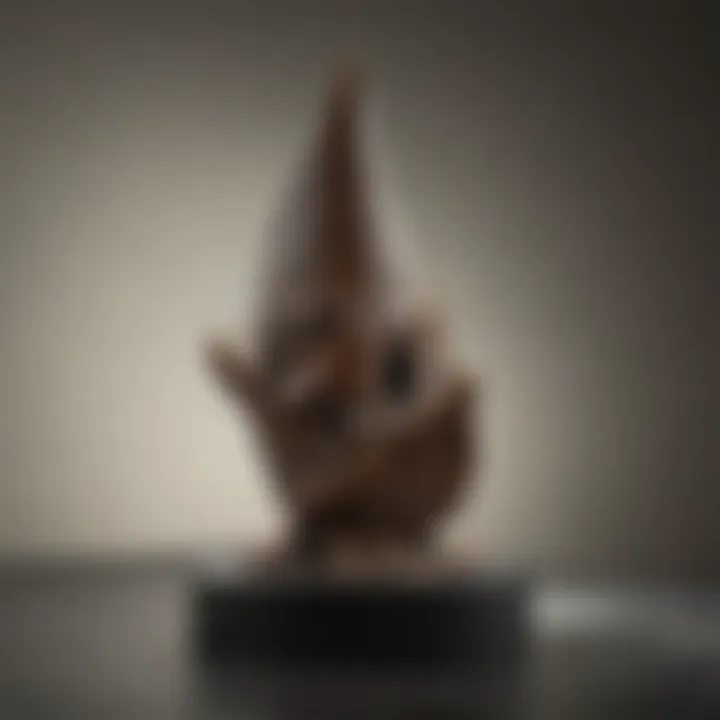
Understanding how display stands can influence education is essential, both for collectors aiming to share their passion and educators seeking to inspire the next generation of paleontologists.
Sustainability in Display Stand Choices
As the world becomes increasingly aware of environmental issues, the importance of sustainability in various sectors cannot be understated. The realm of shark tooth collecting is no exception. Recognizing the environmental implications of display stands is crucial for collectors who want their passion to reflect their values. This section dives into eco-friendly materials and the broader impacts of display materials on the environment, emphasizing how collectors can opt for sustainable choices without compromising on aesthetics or functionality.
Eco-Friendly Materials
When it comes to crafting display stands, the materials used play a significant role. Eco-friendly materials are not just a trend; they represent a validated approach to reducing one’s carbon footprint. Options such as bamboo, reclaimed wood, and recycled metals are becoming more popular among collectors who wish to showcase their prized shark teeth responsibly.
- Bamboo: This fast-growing grass is a renewable resource. It’s sturdy, lightweight, and can be customized easily. Using bamboo for display stands also introduces a natural aesthetic that complements the organic nature of shark teeth.
- Reclaimed Wood: Once destined for landfills, reclaimed wood offers a sustainable alternative. It reduces waste and brings character to displays. You’ll find that each piece tells its own story, adding depth to the collection.
- Recycled Metals: Metal display stands can be crafted from recycled materials, significantly lessening the environmental strain. Using metals like aluminum and steel not only ensures durability but also reflects a commitment to sustainability.
By choosing these materials, collectors can create displays that are not only visually appealing but also environmentally responsible.
Impacts of Display Materials on the Environment
Every choice made regarding display stand materials has ripple effects in the environment. It is essential to consider these impacts to make informed decisions. Here are some factors collectors should understand:
- Resource Extraction: Traditional materials, such as virgin wood and plastics, involve resource extraction that can lead to habitat destruction and increased carbon emissions. Opting for sustainable materials helps mitigate this problem.
- Life Cycle Assessment: Evaluating the life cycle of display materials—from production to end-of-life—can reveal their environmental impacts. Plastic often takes centuries to decompose, and its production involves harmful emissions. In contrast, sustainable materials typically have shorter life cycles and lower emissions.
- Carbon Footprint: The transportation of materials contributes significantly to carbon footprints. Sourcing local materials can minimize transportation distances and reduce emissions. Many eco-friendly options can be found within regional markets, which not only supports local economies but also lowers environmental impact.
- Waste Generation: Lastly, the manufacturing processes of sustainable materials often produce less waste compared to conventional materials. By opting for them, collectors support methods that respect the environment and create positive changes in production standards.
"Choosing sustainable materials isn't just about making your display look good; it's about being part of a movement that values our planet."
Cultural Significance of Shark Teeth
Shark teeth hold a rich tapestry of meaning across various cultures, transcending their mere physical presence. This section explores what these ancient relics signify to different societies, how they play a role in rituals, and their value as artistic expressions. Understanding the cultural significance is crucial, not just for collectors but for anyone fascinated by the historical context of these unique items.
Shark Teeth in Different Cultures
Shark teeth are more than fossilized remains; they are imbued with cultural narratives that span the globe. In many Pacific Island cultures, shark teeth are considered a symbol of strength and courage. The indigenous peoples of Hawaii, for instance, utilize shark teeth in their traditional weaponry and ornaments, believing they bestow protection and prowess. Fishermen often wear shark tooth necklaces, viewing them as talismans that enhance their hunting skills while paying homage to the ocean's fierce predator.
In other regions, such as Polynesia, shark teeth feature prominently in ceremonial attire. They are crafted into decorative pieces that signify status and bravery. The Fiji Islands are renowned for their shark tooth clubs, known as "tabua," which play a pivotal role in both warfare and chiefdom ceremonies. The intricate designs on these clubs tell stories of lineage and triumph, linking the people to their ancestral past.
"In many societies, shark teeth stand as proof of human resilience against nature's untamed forces, embodying qualities we strive to emulate, such as bravery and adaptability."
Furthermore, shark teeth also appear in African cultures, where they often represent wealth and heritage. In West Africa, for example, they are used in amulets and jewelry, believed to enhance the bearer's luck and health. This practice highlights how the intrinsic value of shark teeth extends beyond their aesthetic appeal; they are esteemed as conduits of personal and communal identity.
The Symbolism of Shark Teeth
The symbolism surrounding shark teeth varies, yet there are several common themes that emerge across different cultures. Primarily, they symbolize fearlessness and dominance, much like the predators themselves. This aligns with how various societal structures celebrate prowess, whether it be in combat, fishing, or artistry.
In many totemic belief systems, shark teeth are seen as tokens of the ocean's spirit, serving as bridge connecting the material and spiritual worlds. For instance, in Māori culture, shark teeth might be worn during spiritual ceremonies to connect with the ancestors, illustrating the dual role these relics play as both physical adornments and spiritual artifacts.
Moreover, shark teeth are sometimes viewed as potent symbols of evolution and survival, embodying the resilience of life on Earth. Their ability to withstand the tests of time makes them a powerful reminder of the natural world's enduring legacy. Collectors often find themselves captivated by the narrative that each tooth carries—an everlasting testament to the sharks' dominance in marine ecosystems throughout the ages.
Showcasing Your Collection
When it comes to shark tooth collecting, how you present your pieces can make or break their appeal. Displaying these natural wonders allows collectors not only to appreciate the beauty and uniqueness of each tooth but also to share their passion with others. An engaging display can be the difference between a visual feast for the eyes and a haphazard array of teeth tossed on a shelf.
One of the major elements to consider in showcasing your collection involves the choice of display stand. Each type—be it wall-mounted, tabletop, or rotating—offers a distinct way to feature your sharks’ teeth. Choosing a stand that resonates with your collection's size and style will greatly enhance its visual impact. The right display acts as a stage, highlighting the intricate details of each specimen.
Benefits of showcasing extend beyond mere aesthetics. An organized display not only protects the teeth from damage but also allows for better cleaning and maintenance. When arranged correctly, collectors can also observe how different specimens complement each other in terms of size, color, and age.
Here are a few considerations when planning how to showcase your collection effectively:
- Lighting: Make sure to illuminate your display. Good lighting reveals the textures and colors of the shark teeth.
- Spacing: Don’t crowd your teeth. Give each one enough space to breathe; too close together dilutes their individual presence.
- Labeling: Consider adding labels. These can provide valuable information about each piece, such as origin and age, enhancing educational value for viewers.
"A well-organized collection tells a story—of adventure, patience, and a connection with the ancient oceans. Each shark tooth has a past, and with the right display, it can speak volumes."
Collectively, the importance of the display reflects not just personal pride but also a sharing of culture and knowledge with others. Whether for friends, family, or a wider audience, a well-curated display generates conversation and interest. It transforms a simple collection of artifacts into an exhibition celebrating the allure of the ocean's ancient predators.
Participating in Trade Shows and Exhibitions
Participating in trade shows and exhibitions is a thrilling opportunity for collectors to elevate their shark tooth collection to new heights. These events present a platform to connect with like-minded individuals, receive feedback, and potentially trade or sell specimens. Setting up a booth that reflects your collection’s theme can attract others’ attention and spark memorable conversations.
A display at a trade show allows you to:
- Network: Meet fellow enthusiasts and experts in the field who can offer insights and share experiences.
- Gain Exposure: Introduce your collection to a broader audience, increasing visibility.
- Learn: Engage in workshops or talks that often occur at these events, providing educational insights that can enrich future collecting endeavors.
Sharing Online: Trends and Best Practices
In today’s digital age, sharing your shark tooth collection online has grown immensely popular. Social media platforms and collectible forums have become vibrant communities for enthusiasts to showcase their specimens. Engaging with these platforms can create lasting connections.
When sharing online, consider the following trends and best practices:
- Quality Photos: Invest time in capturing high-resolution images of your collection. Good lighting and angles can showcase the teeth's unique textures.
- Educational Content: Share stories behind your teeth or detailed information about their origins. This kind of content resonates well with the audience.
- Engagement: be active. Respond to comments, ask questions, and join discussions to stay involved with your community.
- Showcase DIY Projects: If you’ve created custom display stands or engaged in anything pertaining to your collection, share these processes with fellow collectors.
By sharing your collection both physically at trade shows and digitally online, you not only elevate your own status within the community but also contribute to the collective appreciation of these remarkable natural artifacts.
The End
In this exploration of shark tooth display stands, we have shed light on several critical aspects of displaying these remarkable fossils. Understanding the role of a well-crafted display stand can enhance not only the aesthetic appeal of one’s collection but also its educational and environmental significance. Display stands are not just holders for shark teeth; they serve as a bridge connecting the collector to the rich history and science that these specimens embody.
Synthesizing the Insights
Through the various sections discussed, it has become clear that the art of displaying shark teeth involves a thoughtful balance of form and function. Collectors benefit from stands that showcase their treasures effectively while maintaining the teeth's security and preserving their integrity.
- Visibility: An optimal stand draws attention to the unique characteristics of each tooth, facilitating appreciation.
- Security: Protecting these valuable specimens from damage is vital.
- Aesthetic Choices: The materials and designs of the stands contribute significantly to the overall look and feel of the display.
In summary, presenting shark teeth with intention not only elevates the collector's experience but also fosters greater appreciation for paleontology among onlookers. By synthesizing these insights, collectors can create displays that tell a story about their specimens, sparking curiosity and enhancing educational value.
Future Trends in Shark Tooth Display
Looking ahead, we can anticipate several exciting trends in the realm of shark tooth display stands. With sustainable practices on the rise, eco-friendly materials will likely take center stage in future designs.
- Sustainable Materials: Expect to see more options made from recycled or responsibly sourced materials.
- Smart Displays: As technology continues to evolve, integrating smart features into display stands may become commonplace. Think of stands equipped with sensors that could offer information or stories about each tooth when approached.
- Customization Opportunities: More DIY solutions and customizable stands will emerge, allowing collectors to create displays that reflect personal styles or collection themes.
In closing, the art of displaying shark teeth is evolving, shaped by advancements in design and a growing consciousness about sustainability. Collectors who stay attuned to these trends will not only enhance their own collections but also contribute positively to the broader fossil community.



